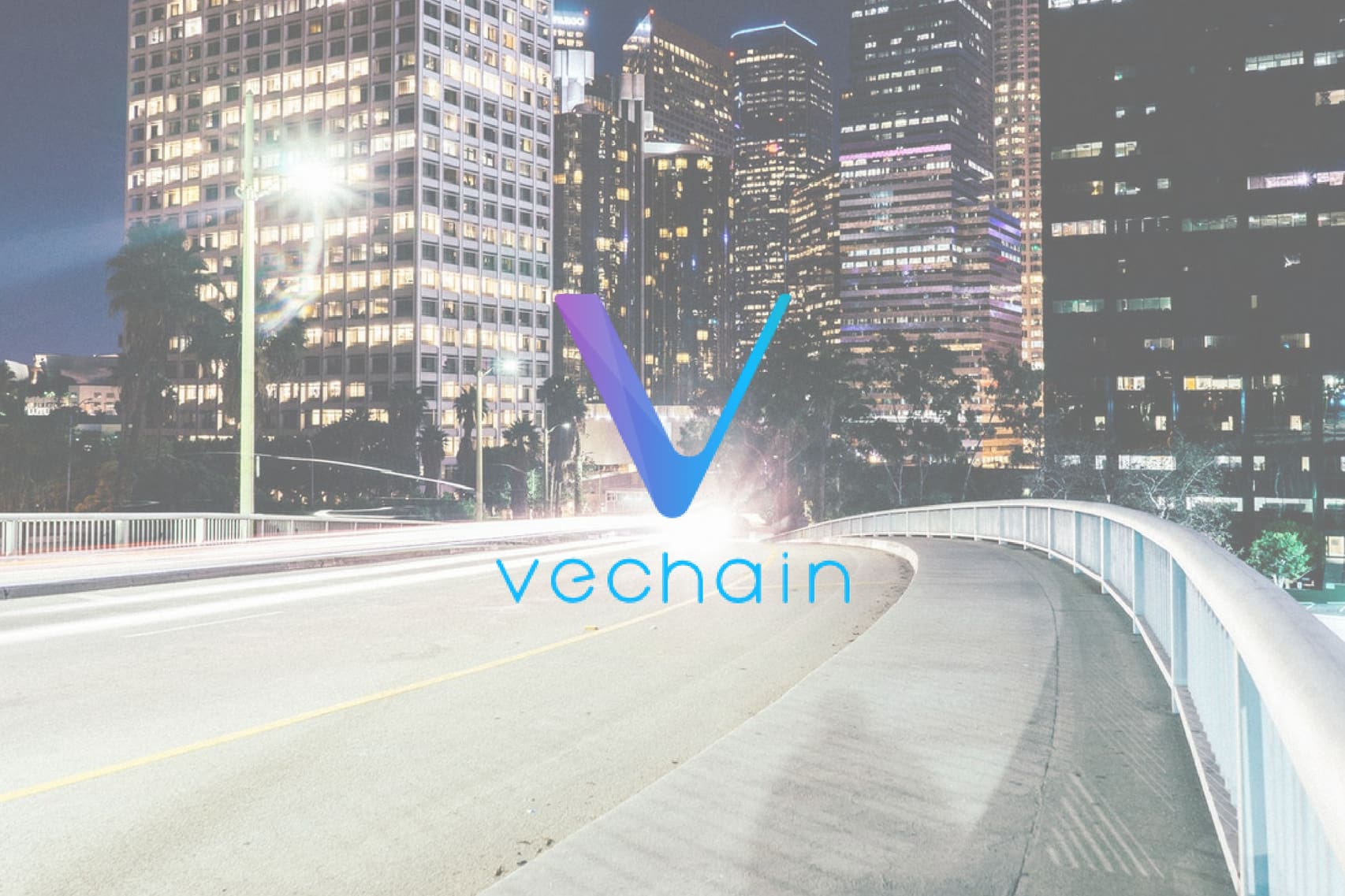On May 20, 2018, the VeChain team released its much anticipated whitepaper.
There are already several documents explaining the VeChain platform and technicalities, as well as websites with user generated VeChain news and opinions, but these documents, news and opinions are merely starting points for describing VeChain’s complex and highly ambitious platform. With a growing list of partners and industries, and especially with the upcoming launch of the VeChain Thor mainnet, a whitepaper has become a necessity, and the team has finally delivered.
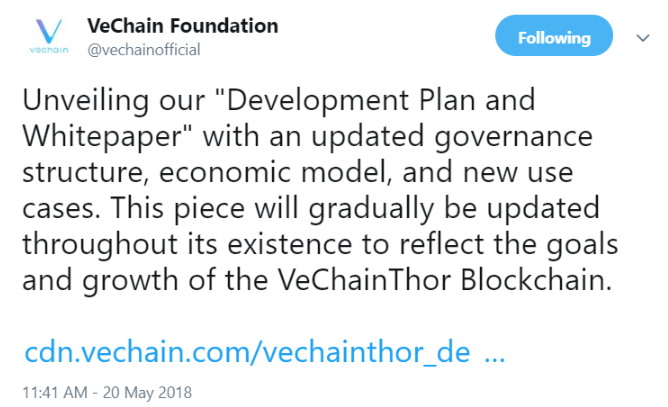
VeChain’s whitepaper was received with much enthusiasm in the community, with some even calling it “114 pages of gold.” In this article, we’ll discuss the most notable segments of VeChain’s development plan and impressively well-written whitepaper.
In the introduction of the whitepaper, the VeChain team states that they’ve conducted intense research, with the help of their business partners, into how to become the go-to blockchain for enterprise solutions. From this research, the VeChain team concluded that it is not the technology itself that is blocking businesses from using blockchain-based applications, but 4 other concerns:
- Governance models
- Economic models
- Useful applications
- Regulatory compliance
The VeChain team has thus designed their to-be-launched platform based on these 4 enterprise-level concerns.
One important thing to mention before discussing the whitepaper is the team’s announcement that a 1:100 token split is going to occur. This means that 1 VET will become 100 VET.
This is to prevent too many fractional VET transactions (paying 0.003 VET for this dapp, 0.0047 VET for that smart contract) which can be confusing and difficult to work with. By multiplying the number of VET tokens by 100 and thus dividing the value of VET by an equal amount, the VeChain team tries to make costs and transactions more practical (3 VET for this dapp, 4.7 VET for that smart contract).
All the information in this article that includes VET calculations is based on the future number of VET tokens.
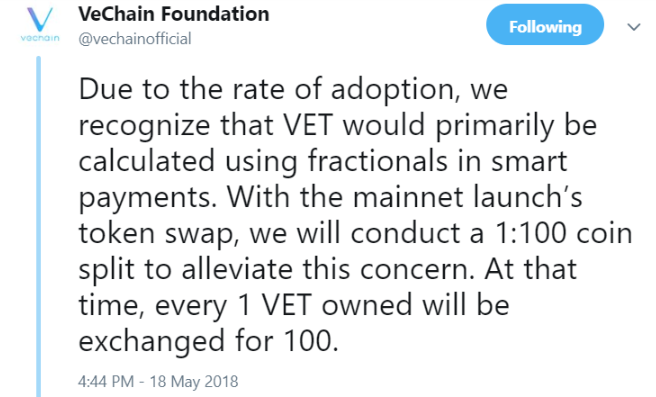
The VeChain Thor Governance Model
Blockchain governance generally comes with a paradox: namely, that complete decentralization is the most secure model, but that comes with serious inefficiencies. To tackle this problem, VeChain Thor’s governance model balances centralization and decentralization.
The governance structure and principles are designed for visibility, inclusiveness, transparency, flexibility and efficiency.
The nonprofit VeChain Foundation is the governing body of the VeChain Thor platform and is led by the Board of Steering Committee. This committee is selected by identifiable (KYC-compliant) stakeholders (VET token holders) with voting authority (VET masternodes), and is responsible for setting out the critical strategies and appointing committees.
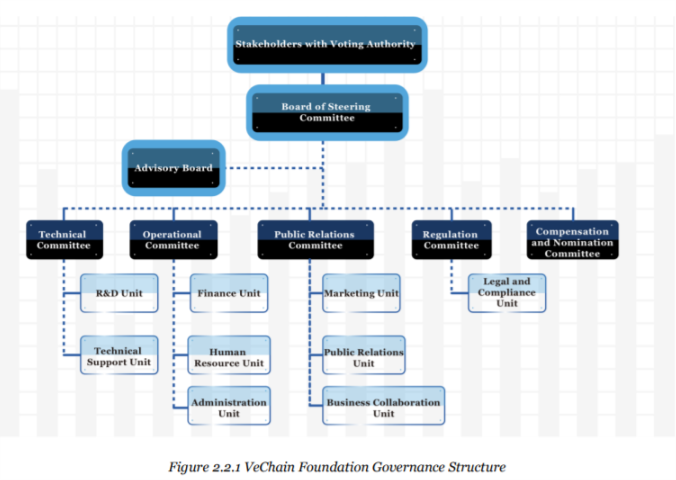
To become a VeChain stakeholder, these are the minimal requirements.

These categories subsequently form the basis of the voting authority model, in which 101 active authority masternode holders are the delegates that verify transactions, produce blocks, and store records on the ledger.
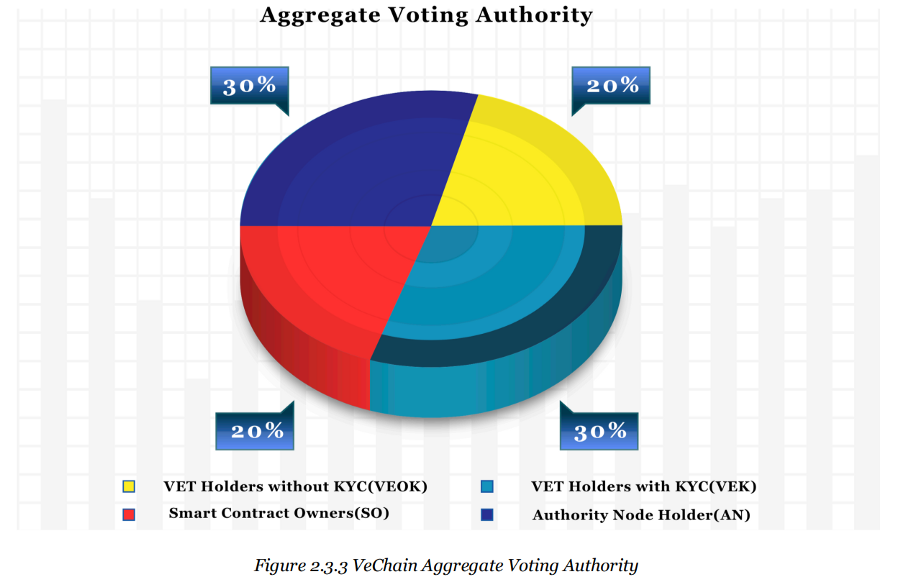
For details on all the different entities in this governance model, check out chapter 2 of the whitepaper.
The VeChain Thor Economic Model
The VeChain team states that the economic models of most existing blockchains are based on transaction fees, which they regard as a serious problem. This is because the more a blockchain is used, the higher its tokens will be valued, which increases transaction costs (transaction costs are calculated in a platform’s native token) and vice versa.
This is bad for business, as VeChain wants stable, cheap, and fast transaction costs.
The VeChain Thor platform will run on a 2-token system, using the VeChain Token (VET) and the VeThor (VTHO) token. VET is “smart money” in its ecosystem and programmable in that it enables smart contracts to carry value. It is used by developers to let smart contracts and dapps operate in the ecosystem.
VTHO is used to pay for the cost of using the VeChain Thor platform, such as dapps and smart contracts. VTHO is generated via holding VET tokens (1 VET generates 0.000432 VTHO per 24 hours), a dynamic which grants long-term token holders free transactions on the platform.
A cool feature introduced by the whitepaper is the economy masternodes. These are masternodes that can be run by anyone with more than 1,000,000 VET after the token split, thus 10,000 VET now.
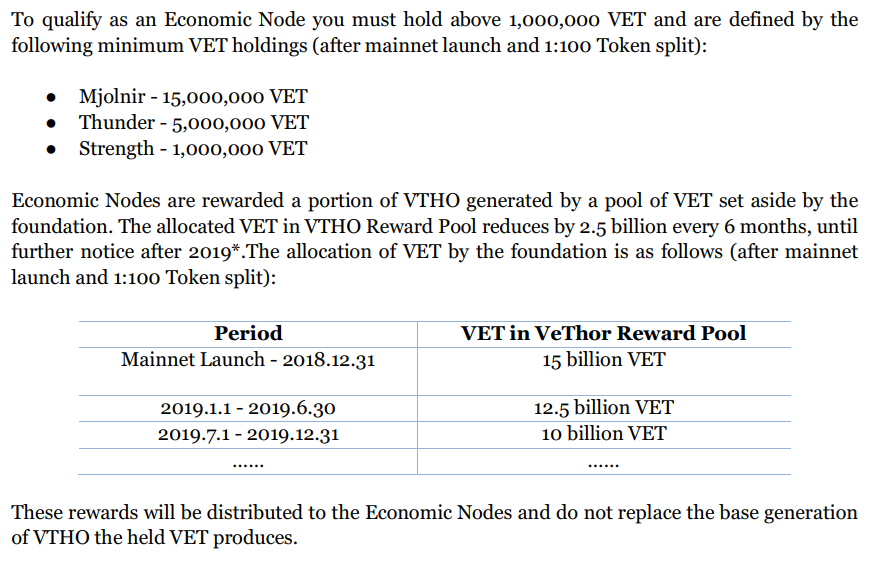 Additionally, transactions on the VeChain Thor platform can be paid by 3 parties: the sender, the receiver, and the sponsor of the smart contract. This allows for entirely new payment models for smart contracts.
Additionally, transactions on the VeChain Thor platform can be paid by 3 parties: the sender, the receiver, and the sponsor of the smart contract. This allows for entirely new payment models for smart contracts.
The VeChain Thor Applications
Based on its research, the VeChain team concluded that enterprises want more out of a blockchain platform than just blockchain applications. They want to be able to integrate other technologies such as AI, Big Data management, and IoT solutions on the blockchain too.
Based on this, the VeChain Thor platform is designed to provide an exhaustive ecosystem which includes a wide variety of business-oriented applications. The infrastructure is created in such a way that it supports all kinds of open business solutions that add value or increase efficiencies for the companies that are part of the ecosystem.
Therefore, the goal of the VeChain team has always been to create a platform that allows for the creation of use case-driven applications, instead of creating applications and hoping they will be used.
The team has therefore laid the foundation to create an exhaustive enterprise ecosystem, but the network will do the rest. Parts of this foundation are the predesigned applications such as VeVID for KYC identification, VeVOT for voting, VeSCC for smart contract certification, and many more relating to technical protocols that are hard to design, but easy and highly necessary to implement.
Moreover, these applications have been put in place to enable and ensure regulatory compliances.
To make the platform even more accessible, “one click deployment solutions” have been installed. These solutions make it easy for business owners to easily build and manage smart contracts, APIs, and nodes.
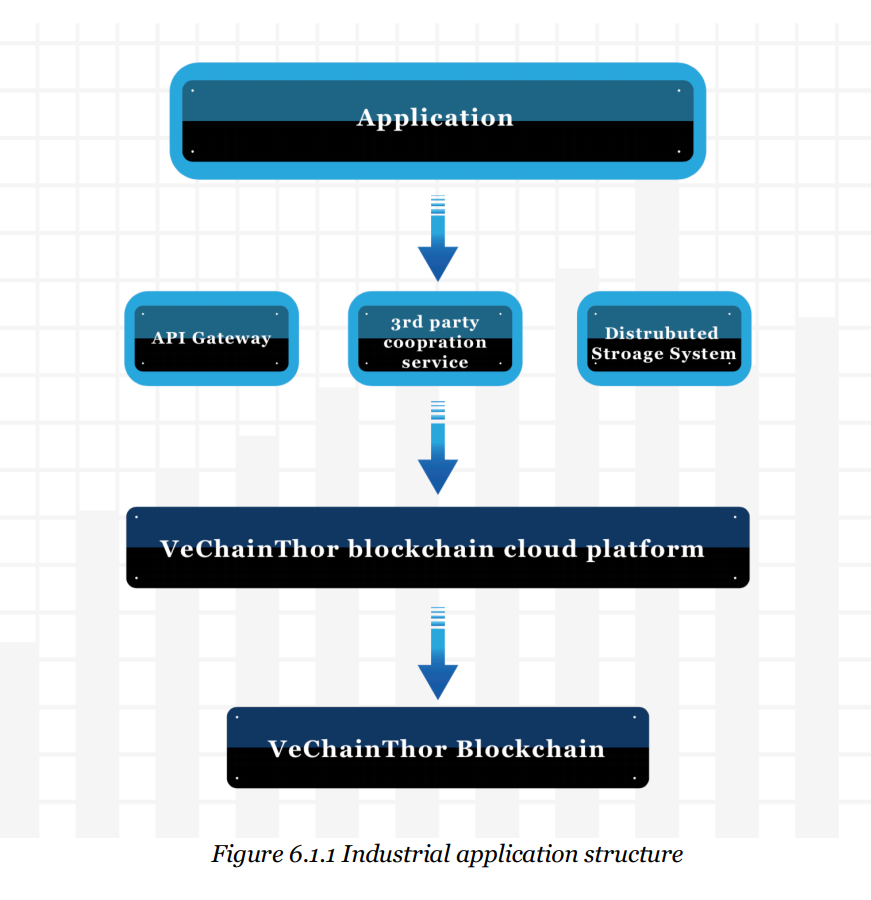
Concluding Remarks
The whitepaper displays a profound understanding of the environment VeChain operates in and is trying to disrupt. I encourage everybody to read the whitepaper themselves, as it describes not only VeChain, but also the blockchain industry and its potential.
The whitepaper clearly underlines the focus of the platform: creating a collaborative ecosystem in which businesses can efficiently cooperate on creating and using valuable business applications, and dramatically reducing the cost of trust.
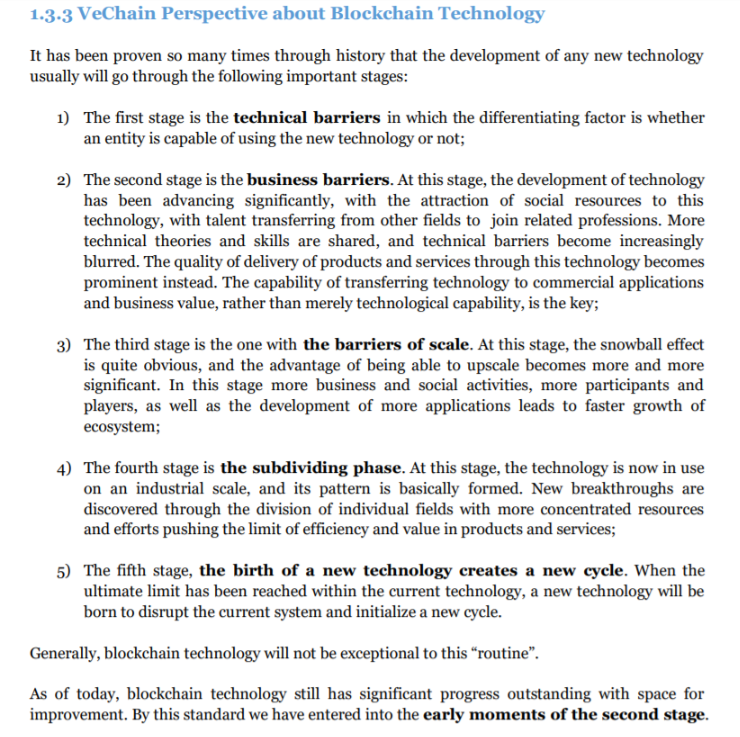 The team is building the VeChain Thor platform with the concerns of their potential users (enterprises) in mind and because of this, their soon-to-be-released platform could be one of the first ones to truly show the world the benefits of blockchain technology.
The team is building the VeChain Thor platform with the concerns of their potential users (enterprises) in mind and because of this, their soon-to-be-released platform could be one of the first ones to truly show the world the benefits of blockchain technology.
The team understands that the real obstacle to making the potential of blockchain technology a reality is the absence of actual practical use cases of the technology. With this in mind, they designed the VeChain Thor platform to be as valuable and efficiency-boosting to enterprises as possible.
The goal is to make VeChain Thor the platform to spark mass adoption of blockchain technology by showing the world how blockchain technology can be the best solution available.
The action starts with the official launch of the Vechain Thor platform, which is scheduled to occur on June 30. You can keep up with VeChain on their Reddit, Telegram and Twitter.

